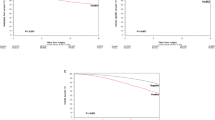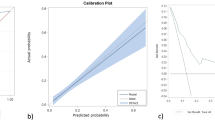Abstract
This review analyzes the anatomy of the prostate gland's lymphatic drainage, the optimal anatomic extend of pelvic lymph node dissection (PLND) and which dissection may be superior, who should undergo a PLND during prostatectomy, and its potential therapeutic benefits and complications. The prostate gland's lymphatic drainage can be variable, but frequently metastatic disease is found in the internal iliac chain. We conclude that the extended PLND yields the most lymph nodes and therefore may be superior. Some have demonstrated an unproven survival benefit after performing an extended PLND, possibly from removal of occult disease or from more accurate staging.
This is a preview of subscription content, access via your institution
Access options
Subscribe to this journal
Receive 4 print issues and online access
$259.00 per year
only $64.75 per issue
Buy this article
- Purchase on Springer Link
- Instant access to full article PDF
Prices may be subject to local taxes which are calculated during checkout

Similar content being viewed by others
References
Bader P, Burkhard FC, Markwalder R, Studer UE . Disease progression and survival of patients with positive lymph nodes after radical prostatectomy. Is there a chance of cure? J Urol 2003; 169: 849–854.
Allaf ME, Palapattu GS, Trock BJ, Carter HB, Walsh PC . Anatomical extent of lymph node dissection: impact on men with clinically localized prostate cancer. J Urol 2004; 172: 1840–1844.
Cheng L, Zincke H, Blute ML, Bergstralh EJ, Scherer B, Bostwick DG . Risk of prostate carcinoma death in patients with lymph node metastasis. Cancer 2001; 91: 66–73.
Joslyn SA, Konety BR . Impact of extent of lymphadenectomy on survival after radical prostatectomy for prostate cancer. Urology 2006; 68: 121–125.
Cellini N, Luzi S, Mantini G, Mattiucci GC, Morganti AG, Digesù C et al. Lymphatic drainage and CTV in carcinoma of the prostate. Rays 2003; 28: 337–341.
Gil-Vernet JM . Prostate cancer: anatomical and surgical considerations. Br J Urol 1996; 78: 161–168.
Weingartner K, Ramaswamy A, Bittinger A, Gerharz EW, Vöge D, Riedmiller H . Anatomical basis for pelvic lymphadenectomy in prostate cancer: results of an autopsy study and implications for the clinic. J Urol 1996; 156: 1969–1971.
Schuessler WW, Pharand D, Vancaillie TG . Laparoscopic standard pelvic node dissection for carcinoma of the prostate: is it accurate? J Urol 1993; 150: 898–901.
Sivalingam S, Oxley J, Probert JL, Stolzenburg JU, Schwaibold H . Role of pelvic lymphadenectomy in prostate cancer management. Urology 2007; 69: 203–209.
Heidenreich A, Varga Z, Von Knobloch R . Extended pelvic lymphadenectomy in patients undergoing radical prostatectomy: high incidence of lymph node metastasis. J Urol 2002; 167: 1681–1686.
Heidenreich A, Ohlmann CH, Polyakov S . Anatomical extent of pelvic lymphadenectomy in patients undergoing radical prostatectomy. Eur Urol 2007; 52: 29–37.
Stone NN, Stock RG, Unger P . Laparoscopic pelvic lymph node dissection for prostate cancer: comparison of the extended and modified techniques. J Urol 1997; 158: 1891–1894.
Bader P, Burkhard FC, Markwalder R, Studer UE . Is a limited lymph node dissection an adequate staging procedure for prostate cancer? J Urol 2002; 168: 514–518; discussion 518.
Briganti A, Chun FK, Salonia A, Zanni G, Scattoni V, Valiquette L et al. Validation of a nomogram predicting the probability of lymph node invasion among patients undergoing radical prostatectomy and an extended pelvic lymphadenectomy. Eur Urol 2006; 49: 1019–1026.
Briganti A, Chun FK, Salonia A, Gallina A, Farina E, Da Pozzo LF et al. Validation of a nomogram predicting the probability of lymph node invasion based on the extent of pelvic lymphadenectomy in patients with clinically localized prostate cancer. BJU Int 2006; 98: 788–793.
Wawroschek F, Hamm M, Weckermann D, Vogt H, Harzmann R . Lymph node staging in clinically localized prostate cancer. Urol Int 2003; 71: 129–135.
Wawroschek F, Vogt H, Wengenmair H, Weckermann D, Hamm M, Keil M et al. Prostate lymphoscintigraphy and radio-guided surgery for sentinel lymph node identification in prostate cancer. Technique and results of the first 350 cases. Urol Int 2003; 70: 303–310.
Clark T, Parekh DJ, Cookson MS, Chang SS, Smith Jr ER, Wells N et al. Randomized prospective evaluation of extended versus limited lymph node dissection in patients with clinically localized prostate cancer. J Urol 2003; 169: 145–147; discussion 147–148.
Berglund RK, Sadetsky N, DuChane J, Carroll PR, Klein EA . Limited pelvic lymph node dissection at the time of radical prostatectomy does not affect 5-year failure rates for low, intermediate and high risk prostate cancer: results from CaPSURE. J Urol 2007; 177: 526–529; discussion 529–530.
Danella JF, deKernion JB, Smith RB, Steckel J . The contemporary incidence of lymph node metastases in prostate cancer: implications for laparoscopic lymph node dissection. J Urol 1993; 149: 1488–1491.
Petros JA, Catalona WJ . Lower incidence of unsuspected lymph node metastases in 521 consecutive patients with clinically localized prostate cancer. J Urol 1992; 147: 1574–1575.
Partin AW, Mangold LA, Lamm DM, Walsh PC, Epstein JI, Pearson JD . Contemporary update of prostate cancer staging nomograms (Partin Tables) for the new millennium. Urology 2001; 58: 843–848.
Partin AW, Yoo J, Carter HB, Pearson JD, Chan DW, Epstein JI et al. The use of prostate specific antigen, clinical stage and Gleason score to predict pathological stage in men with localized prostate cancer. J Urol 1993; 150: 110–114.
Partin AW, Kattan MW, Subong EN, Walsh PC, Wojno KJ, Oesterling JE et al. Combination of prostate-specific antigen, clinical stage, and Gleason score to predict pathological stage of localized prostate cancer. A multi-institutional update. JAMA 1997; 277: 1445–1451.
Kattan MW, Eastham JA, Stapleton AM, Wheeler TM, Scardino PT . A preoperative nomogram for disease recurrence following radical prostatectomy for prostate cancer. J Natl Cancer Inst 1998; 90: 766–771.
Cagiannos I, Karakiewicz P, Eastham JA, Ohori M, Rabbani F, Gerigk C et al. A preoperative nomogram identifying decreased risk of positive pelvic lymph nodes in patients with prostate cancer. J Urol 2003; 170: 1798–1803.
Cooperberg MR, Freedland SJ, Pasta DJ, Elkin EP, Presti Jr JC, Amling CL et al. Multi-institutional validation of the UCSF cancer of the prostate risk assessment for prediction of recurrence after radical prostatectomy. Cancer 2006; 107: 2384–2391.
Kondylis FI, Moriarty RP, Bostwick D, Schellhammer PF . Prostate cancer grade assignment: the effect of chronological, interpretive and translation bias. J Urol 2003; 170: 1189–1193.
Burkhard FC, Bader P, Schneider E, Markwalder R, Studer UE . Reliability of preoperative values to determine the need for lymphadenectomy in patients with prostate cancer and meticulous lymph node dissection. Eur Urol 2002; 42: 84–90; discussion 90–82.
Narayan P, Fournier G, Gajendran V, Leidich R, Lo R, Wolf Jr JS et al. Utility of preoperative serum prostate-specific antigen concentration and biopsy Gleason score in predicting risk of pelvic lymph node metastases in prostate cancer. Urology 1994; 44: 519–524.
Bluestein DL, Bostwick DG, Bergstralh EJ, Oesterling JE . Eliminating the need for bilateral pelvic lymphadenectomy in select patients with prostate cancer. J Urol 1994; 151: 1315–1320.
Kawakami J, Meng MV, Sadetsky N, Latini DM, Duchane J, Carroll PR et al. Changing patterns of pelvic lymphadenectomy for prostate cancer: results from CaPSURE. J Urol 2006; 176: 1382–1386.
Conrad S, Graefen M, Pichlmeier U, Henke RP, Hammerer PG, Huland H . Systematic sextant biopsies improve preoperative prediction of pelvic lymph node metastases in patients with clinically localized prostatic carcinoma. J Urol 1998; 159: 2023–2029.
Conrad S, Graefen M, Pichlmeier U, Henke RP, Erbersdobler A, Hammerer PG et al. Prospective validation of an algorithm with systematic sextant biopsy to predict pelvic lymph node metastasis in patients with clinically localized prostatic carcinoma. J Urol 2002; 167: 521–525.
Graefen M, Pichlmeier U, Hammerer PG, Haese A, Butz K, Erbersdobler A et al. A validated strategy to select patients for a nerve-sparing radical prostatectomy. Prostate Cancer Prostatic Dis 2000; 3: S18.
Haese A, Epstein JI, Huland H, Partin AW . Validation of a biopsy-based pathologic algorithm for predicting lymph node metastases in patients with clinically localized prostate carcinoma. Cancer 2002; 95: 1016–1021.
Schumacher MC, Burkhard FC, Thalmann GN, Fleischmann A, Studer UE . Is pelvic lymph node dissection necessary in patients with a serum PSA<10 ng/ml undergoing radical prostatectomy for prostate cancer? Eur Urol 2006; 50: 272–279.
Grossfeld GD, Chang JJ, Broering JM, Li YP, Lubeck DP, Flanders SC et al. Under staging and under grading in a contemporary series of patients undergoing radical prostatectomy: results from the cancer of the prostate strategic urologic research endeavor database. J Urol 2001; 165: 851–856.
Bhatta-Dhar N, Reuther AM, Zippe C, Klein EA . No difference in six-year biochemical failure rates with or without pelvic lymph node dissection during radical prostatectomy in low-risk patients with localized prostate cancer. Urology 2004; 63: 528–531.
Han M, Partin AW, Pound CR, Epstein JI, Walsh PC . Long-term biochemical disease-free and cancer-specific survival following anatomic radical retropubic prostatectomy. The 15-year Johns Hopkins experience. Urol Clin N Am 2001; 28: 555–565.
Catalona WJ, Miller DR, Kavoussi LR . Intermediate-term survival results in clinically understaged prostate cancer patients following radical prostatectomy. J Urol 1988; 140: 540–543.
Golimbu M, Provet J, Al-Askari S, Morales P . Radical prostatectomy for stage D1 prostate cancer. Prognostic variables and results of treatment. Urology 1987; 30: 427–435.
Frazier II HA, Robertson JE, Paulson DF . Does radical prostatectomy in the presence of positive pelvic lymph nodes enhance survival? World J Urol 1994; 12: 308–312.
Salomon L, Hoznek A, Lefrère-Belda MA, Bellot J, Chopin DK, Abbou CC . Nondissection of pelvic lymph nodes does not influence the results of perineal radical prostatectomy in selected patients. Eur Urol 2000; 37: 297–300.
Dillioglugil O, Leibman BD, Leibman NS, Kattan MW, Rosas AL, Scardino PT . Risk factors for complications and morbidity after radical retropubic prostatectomy. J Urol 1997; 157: 1760–1767.
Campbell SC, Klein EA, Levin HS, Piedmonte MR . Open pelvic lymph node dissection for prostate cancer: a reassessment. Urology 1995; 46: 352–355.
Dhar NB, Burkhard FC, Studer UE . Role of lymphadenectomy in clinically organ-confined prostate cancer. World J Urol 2007; 25: 39–44.
Michl UH, Friedrich MG, Graefen M, Haese A, Heinzer H, Huland H . Prediction of postoperative sexual function after nerve sparing radical retropubic prostatectomy. J Urol 2006; 176: 227–231.
Burkhard FC, Kessler TM, Fleischmann A, Thalmann GN, Schumacher M, Studer UE . Nerve sparing open radical retropubic prostatectomy—does it have an impact on urinary continence? J Urol 2006; 176: 189–195.
Author information
Authors and Affiliations
Corresponding author
Rights and permissions
About this article
Cite this article
Breyer, B., Greene, K., Dall'Era, M. et al. Pelvic lymphadenectomy in prostate cancer. Prostate Cancer Prostatic Dis 11, 320–324 (2008). https://doi.org/10.1038/pcan.2008.29
Received:
Accepted:
Published:
Issue Date:
DOI: https://doi.org/10.1038/pcan.2008.29
Keywords
This article is cited by
-
Magnetic resonance imaging improves the prediction of tumor staging in localized prostate cancer
Abdominal Radiology (2021)
-
A systematic review and meta-analysis of comparative studies on the efficacy of extended pelvic lymph node dissection in patients with clinically localized prostatic carcinoma
Journal of Cancer Research and Clinical Oncology (2014)



